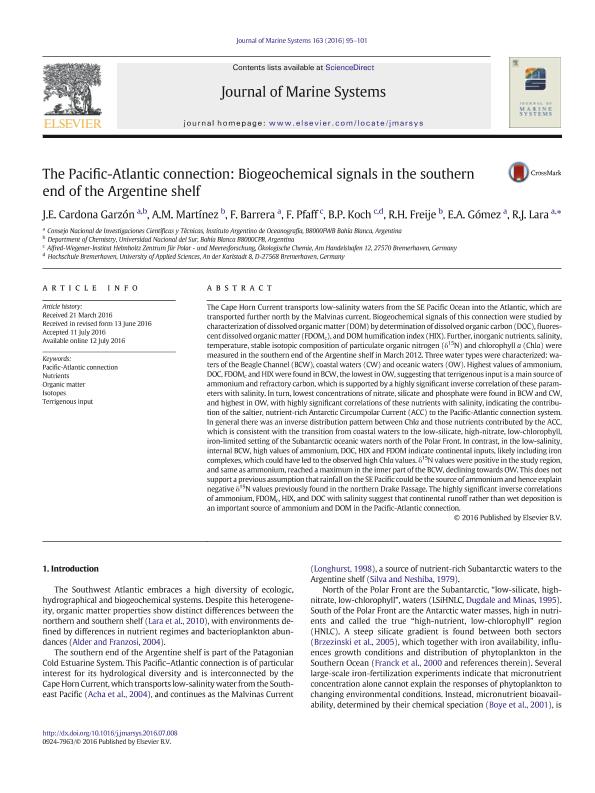Mostrar el registro sencillo del ítem
dc.contributor.author
Garzon Cardona, John Edison

dc.contributor.author
Martinez, Ana María

dc.contributor.author
Barrera, Facundo Matías

dc.contributor.author
Pfaff, F.
dc.contributor.author
Koch, B. P.
dc.contributor.author
Freije, Rubén Hugo

dc.contributor.author
Gomez, Eduardo Alberto

dc.contributor.author
Lara, Ruben Jose

dc.date.available
2017-10-12T18:31:23Z
dc.date.issued
2016-07
dc.identifier.citation
Garzon Cardona, John Edison; Martinez, Ana María; Barrera, Facundo Matías; Pfaff, F.; Koch, B. P.; et al.; The Pacific-Atlantic connection: biogeochemical signals in the southern end of the Argentine shelf; Elsevier Science; Journal Of Marine Systems; 163; 7-2016; 95-101
dc.identifier.issn
0924-7963
dc.identifier.uri
http://hdl.handle.net/11336/26481
dc.description.abstract
The Cape Horn Current transports low-salinity waters from the SE Pacific Ocean into the Atlantic, which are transported further north by the Malvinas current. Biogeochemical signals of this connection were studied by characterization of dissolved organic matter (DOM) by determination of dissolved organic carbon (DOC), fluorescent dissolved organic matter (FDOMc), and DOM humification index (HIX). Further, inorganic nutrients, salinity, temperature, stable isotopic composition of particulate organic nitrogen (δ15N) and chlorophyll a (Chla) were measured in the southern end of the Argentine shelf in March 2012. Three water types were characterized: waters of the Beagle Channel (BCW), coastal waters (CW) and oceanic waters (OW). Highest values of ammonium, DOC, FDOMc and HIX were found in BCW, the lowest in OW, suggesting that terrigenous input is a main source of ammonium and refractory carbon, which is supported by a highly significant inverse correlation of these parameters with salinity. In turn, lowest concentrations of nitrate, silicate and phosphate were found in BCW and CW, and highest in OW, with highly significant correlations of these nutrients with salinity, indicating the contribution of the saltier, nutrient-rich Antarctic Circumpolar Current (ACC) to the Pacific-Atlantic connection system. In general there was an inverse distribution pattern between Chla and those nutrients contributed by the ACC, which is consistent with the transition from coastal waters to the low-silicate, high-nitrate, low-chlorophyll, iron-limited setting of the Subantarctic oceanic waters north of the Polar Front. In contrast, in the low-salinity, internal BCW, high values of ammonium, DOC, HIX and FDOM indicate continental inputs, likely including iron complexes, which could have led to the observed high Chla values. δ15N values were positive in the study region, and same as ammonium, reached a maximum in the inner part of the BCW, declining towards OW. This does not support a previous assumption that rainfall on the SE Pacific could be the source of ammonium and hence explain negative δ15N values previously found in the northern Drake Passage. The highly significant inverse correlations of ammonium, FDOMc, HIX, and DOC with salinity suggest that continental runoff rather than wet deposition is an important source of ammonium and DOM in the Pacific-Atlantic connection.
dc.format
application/pdf
dc.language.iso
eng
dc.publisher
Elsevier Science

dc.rights
info:eu-repo/semantics/openAccess
dc.rights.uri
https://creativecommons.org/licenses/by-nc-sa/2.5/ar/
dc.subject
Pacific-Atlantic Connection
dc.subject
Nutrients
dc.subject
Organic Matter
dc.subject
Isotopes
dc.subject
Terrigenous Input
dc.title
The Pacific-Atlantic connection: biogeochemical signals in the southern end of the Argentine shelf
dc.type
info:eu-repo/semantics/article
dc.type
info:ar-repo/semantics/artículo
dc.type
info:eu-repo/semantics/publishedVersion
dc.date.updated
2017-09-19T14:41:20Z
dc.journal.volume
163
dc.journal.pagination
95-101
dc.journal.pais
Países Bajos

dc.journal.ciudad
Amsterdam
dc.description.fil
Fil: Garzon Cardona, John Edison. Consejo Nacional de Investigaciones Científicas y Técnicas. Centro Científico Tecnológico Conicet - Bahía Blanca. Instituto Argentino de Oceanografía. Universidad Nacional del Sur. Instituto Argentino de Oceanografía; Argentina
dc.description.fil
Fil: Martinez, Ana María. Universidad Nacional del Sur. Departamento de Química; Argentina
dc.description.fil
Fil: Barrera, Facundo Matías. Consejo Nacional de Investigaciones Científicas y Técnicas. Centro Científico Tecnológico Conicet - Bahía Blanca. Instituto Argentino de Oceanografía. Universidad Nacional del Sur. Instituto Argentino de Oceanografía; Argentina
dc.description.fil
Fil: Pfaff, F.. Alfred-Wegener-Institut Helmholtz Zentrum für Polar - und Meeresforschung; Alemania
dc.description.fil
Fil: Koch, B. P.. Alfred-Wegener-Institut Helmholtz Zentrum für Polar - und Meeresforschung; Alemania. University of Applied Sciences; Alemania
dc.description.fil
Fil: Freije, Rubén Hugo. Universidad Nacional del Sur. Departamento de Química; Argentina
dc.description.fil
Fil: Gomez, Eduardo Alberto. Consejo Nacional de Investigaciones Científicas y Técnicas. Centro Científico Tecnológico Conicet - Bahía Blanca. Instituto Argentino de Oceanografía. Universidad Nacional del Sur. Instituto Argentino de Oceanografía; Argentina
dc.description.fil
Fil: Lara, Ruben Jose. Consejo Nacional de Investigaciones Científicas y Técnicas. Centro Científico Tecnológico Conicet - Bahía Blanca. Instituto Argentino de Oceanografía. Universidad Nacional del Sur. Instituto Argentino de Oceanografía; Argentina
dc.journal.title
Journal Of Marine Systems

dc.relation.alternativeid
info:eu-repo/semantics/altIdentifier/doi/http://dx.doi.org/10.1016/j.jmarsys.2016.07.008
dc.relation.alternativeid
info:eu-repo/semantics/altIdentifier/url/http://www.sciencedirect.com/science/article/pii/S0924796316302056
Archivos asociados
